- Date of Report: January 30, 2004
-
- Event Location: Field in
front of Kuss farmhouse - Golabki, Poland
Date/Time Occurred: July or early August, 1998 - approximately 2
a.m.
Witness: Mrs. Evelina Kuss, interviewed July 19, 2003
Interviewed By: Nancy Talbott (follow-up of original interview by
Robert Bernatowicz)
Translator: Slawek Paruszewski Field Samplers: Milosz Kuss, Robert
Bernatowicz
Materials Sampled: Black/green "stone," and soils
Analyses By: Nick Reiter (SEM/EDS); Phyllis Budinger (Infrared Spectroscopy)
-
- Description of Event: Mrs.
Kuss, a grandmother who has lived in this very rural area in central Poland
all of her life, has a bedroom on the ground floor of the farmhouse. Her
large windows look out across a country road to her farm fields which extend
150-200 meters, ending in an approximately 10m-long area of wild grasses,
behind which is forest. There are only a few other farmhouses in the area
and few people.
-
-

- Evelina Kuss - Golabki, Poland
Eyewitness to "Burning" UFO, July/August, 1998
Photo: N. Talbott
-
-

- Mrs. Evelina Kuss (eyewitness) and her grandson,
Milosz Kuss in Golalbki, Poland
-
-
-

-
- "Stone" found by Milosz at Landing
Site
-
-
-

-
- Mrs. Kuss' bedroom windows (red arrow) from which
she witnessed event.
Photo: N. Talbott
-
-
-

-
- Field directly across from farmhouse, at end
of which
Mrs. Kuss observed UFO descend and land. Photo: N. Talbott
-
-
- Mrs. Kuss reports that it was about 2 am (in July or
perhaps early August) and she couldn't fall asleep: "I don't know
why, but I couldn't. And suddenly the room simply became all red ... the
whole room became red because there was something glowing outside the window.
I saw this object in the sky. It had the shape of an ellipsis and glowed
in red, a very intense red. ... And it was very slowly lowering itself
onto the field. The glow from this thing was enormous. The whole object
was emitting such light that it reminded me of a bright ball, but with
a distinctive shape inside the glow. And it was going down, very, very
slowly."
-
-
-
-

-
-
-
- Mrs. Kuss' drawing of red "glowing"
object she watched slowly
descend into the field in front of her farmhouse.
[Insert above her drawing is an illustration from another case in which
the UFO had a similar red glow.]
-
-
- At first Mrs. Kuss thought it might be a meteorite, but
realized it couldn't be because it was descending so slowly. Sometimes
it even "stopped" for awhile and would then continue its descent.
The object, which was about 150 meters away from her, appeared to be 3-4
meters across. "I think it could have been several meters in length
... I saw it very clearly, it wasn't very far away, glowing like a piece
of [hot] iron. There had been wheat [in the field] which my son had sown,
but it had been reaped already. And I thought that, since this fire landed
there, the field might catch on fire from it. I even wanted to wake up
my family, but the light began to dim. It was dimming out very, very slowly.
I saw that nothing was on fire, so I went to bed and in the morning during
breakfast I told my family about it, I said that this object had landed
there. And I showed them exactly where it landed."
-
- Mrs. Kuss reports that about 15 minutes elapsed from
the moment she first saw the red glow in her bedroom until the object landed
and became so dim she could no longer see it. She continued to observe
the field for about another hour before finally going to bed. She reports
that she noticed no unusual smell and experienced no tingling of the skin
or other possible electromagnetic effects, and she doesn't recall hearing
any unusual animal noises. The object itself was silent. There are no street-lights
in her area and none of the lights in her house (or the radio or TV) were
on, so she is unaware of any electrical interference which may have been
caused by the object. The only clock observed in the house was hand-wound.
-
-
- Retrieval of "Stone":
The morning after witnessing the UFO Mrs. Kuss told her family, including
her grandson Milosz, about the event at breakfast. After attending to his
chores, Milosz walked down to the end of the field to see if he could find
any traces of the event the night before. At the end of the plowed field
there is a 10-meter-long area of wild grasses & bushes before the forest.
Milosz saw no sign of anything having been burned, instead finding approximately
10-15 "stones" placed on top of the grasses in an "irregular"
circle or ellipse. "I knew straight-away that they had to have something
to do with the object. There were several of them...mostly the size of
a basketball, maybe slightly smaller. ... They made an irregular circle,
they were scattered somewhat irregularly, as if by chance...or as if someone
had put them there delicately. Their weight pressed the ground beneath
them a little. There were no traces of anything burnt. There was this smallest
stone in the middle and I took it immediately. ...
-
- But the other stones were very heavy and I couldn't lift
them [Milosz was 11 years old at the time]. They were dark green in color,
like a green glass bottle and they were somewhat oval in shape...as if
something solidified in huge drops. Their color was exactly the color of
the stone I took."
-
-
-

-
- Small "stone" retrieved by Milosz Kuss
from group of similar, but larger,
rocks found at end of field. Red arrow points to one of
multiple holes pock-marking surface.
Photo: J. Karwat
-
-
-

-
- Drawing by Milosz Kuss of the field & irregular
circle of dark green
"stones" he found lying on the grass at the end of the field,
where his grandmother saw the UFO land.
-
-
-
- Milosz brought the one "smaller" stone back
to the house and told the family what he had found. A day or two later
he took a wheelbarrow with him down to the end of the field in an attempt
to retrieve the rest of the "stones." But when he got there the
stones were no longer there. When asked if people could have taken the
stones he was certain that this was very unlikely: "People? I don't
think so...this is a wild, uninhabited place. Nobody walks here. Who would
go into our field and take such heavy stones? I don't think they were taken
by people, but rather by an object similar to the one that landed here."
-
- When I questioned Milosz's parents they confirmed that
there were very few residents in the area, and that the only people who
ever went into their fields were themselves when they had to work to do.
Other farmers in the region would have all been busy with their own crops
and they knew of no one who might have even known about the UFO sighting,
or the existence of the "stones."
-
-
-

-
- Wild grass area at far end of plowed field where
"stones" were found.
[Date-stamp on photo is incorrect - photo taken July 19, 2003]
Photo: N. Talbott
-
-
-
- Milosz reported additional details about the stones,
in particular that the stone he had retrieved "glowed." "This
is the most important part...I noticed the following night ... that this
stone gives away a delicate glow in the night. I mean, the light was greenish
and only the edges were giving away the light. They [the lights] were like
small glowing flames, or sparkles...it's hard to describe, but it was amazing."
-
- When asked if the whole edge of the stone was glowing
he said that the stone had sharp edges all over it and that the "glowing
points were on the edges." He reports that it continued to glow at
night for about half a year and then stopped.
-
- Milosz also clarified that some of the stones were as
big as cinder-blocks, with some rough edges like the smaller stone he retrieved,
and all a dark greenish color. The stone he recovered is now more black
than green, but it has multiple light-green inclusions (which are visible
in good light). Since it appears that these may have been fluorescing when
the rock was first recovered, this may be why he describes the stones as
basically green, rather than black.
-
-
- Sampling of Soils: In the
late summer of 1998 Milosz and his family could find no one who was particularly
interested in investigating this event (in spite of the fact that other
very strange occurrences had been reported from time to time by other people
in the surrounding area). The family discussed the sighting with a few
people locally, but found that their story was laughed at, and they were
not taken seriously.
-
- In the summer of 2000 a photo of a large crop circle
which had been found in a field in the nearby village of Wylatowo, appeared
in many Polish newspapers--attracting the attention of Warsaw radio reporter
Robert Bernatowicz. Bernatowicz, who is the head of The Nautilus Foundation
(a group interested in unexplained phenomena), visited Wylatowo to examine
the crop formation personally, and soon met Milosz Kuss. Once acquainted,
Milosz related the story about his grandmother's sighting and his retrieval
of the "stone" from the field.
-
- Mr. Bernatowicz followed up with in-depth interviews
with Milosz, Evelina Kuss and others in the area, documenting as many details
as he could. Needing access to more sophisticated technical analyses than
he could find in Poland, Bernatowicz eventually contacted the BLT Research
Team Inc. in the U.S. for assistance. In addition to requiring pieces of
the stone for analysis, BLT requested that soil samples be taken from the
area where the stone had been found, and these were provided by Milosz
during the late spring of 2003. A surface soil sample (down to a depth
of 4 inches) was taken from the grassy area where the rock had been recovered,
as well as control soil from the plowed field up closer to the farmhouse.
The rock pieces and soils were then shipped to the BLT office in Cambridge,
Massachusetts.
-
-
-
- (SEM/EDS analysis)
-
- Laboratory Analysis (SEM/EDS):
On June 3, 2003 two rock fragments were submitted to BLT-consultant Nick
Reiter, of the Avalon Foundation, for scanning electron microscopy/electron
dispersive spectroscopy (SEM/EDS) and other examinations. A few weeks later
soil samples were also submitted. Mr. Reiter's Lab Report follows.
-
-
-

-
- Enlargment of initial rock photo, clearly showing
glassy surface with
multiple circular indentations, indicating gaseous expiration during cooling.
-
-
-

-
- Lab photo of larger sample of glassy stone, in
which
greenish color is apparent. Sample is approx. 1.2 cm. in length.
Photo: N. Reiter, 17 June 2003
-
-
-

-
- Lab photo of both rock samples (in this lighting
glassy surface appears black).
Photo: N. Reiter, 17 June 2003
-
-
- Physical Form: The two glassy
stones are shown in the color photos, above. As may be seen, the larger
sample (before being later split in two) was approximately 1.2 cm long;
the smaller was slightly less than 1 cm. Both are seen to be of similar
color, a very dark green-black. We also observe that small (< 2mm) bubbles
and voids are present in both, consistent with the immediately apparent
notion that these samples are essentially glass.
-
- EDS and Comparative Analysis:
EDS scans taken from assorted spots on both stone samples are quite consistent.
We find Si (silicon), O (oxygen), Al (aluminum), Mg (magnesium), Ca (calcium),
K (potassium) and minor amounts of Fe (iron) and Ti (titanium).
-
-
-

- EDS Scan of fragment from larger (1.2 cm) piece
of glassy stone (150x l5 kV).
Scan is consistent with multiple others carried out on both the larger
& smaller samples. Scan: N. Reiter, 26 June 2003
-
-
- Other Properties:
-
- (1) No noticeable radioactivity was observed upon testing
with a Geiger counter;
- (2) No fluorescence was observed in the visible portion
of the spectrum when samples were exposed to both long- and short-wave
UV.
- (3) Neither sample was magnetic.
-
-
- Discussion: Two analogous
materials may be found which resemble these samples. A semi-precious gemstone
originally derived from ancient meteoric glass in the region of the Moldau
River--called Moldavite--resembles our samples somewhat in form, but not
necessarily in color, as Moldavite is usually a brighter and lighter green.
However the samples do very much resemble vitrified soil, produced by a
well-known toxic or nuclear waste remediation process known as ISV: in-situ
vitrification. In this process electrical arcs are made to flow deep into
soil areas contaminated with toxic wastes or radioactive substances, liquifying
the soil components and producing a non-permeable glassy material as the
liquid soils cools. This glassy residual can then either remain safely
underground (since the toxic wastes are now contained) or can be subsequently
safely hauled away.
-
-

-
- Features and benefits of two different technologies
for in-situ
vitrification, developed by the Geo-Melt (TM) Corp.
Source: www.geomelt.com/technologies/
-
-
-
- Additional Testing: The observation
by the original discoverer of the glassy rock, indicating a long-term phosphorescence
or fluorescence continued to intrigue us. We requested additional samples,
specifically from the lighter-green "veins" reported to be visible
in the stone, and in December, 2003 did receive an additional small (<
2mm diam.) light green glassy shard for analysis.
-
- EDS revealed the composition of this new sample to be
quite similar to the samples already examined; however, SEM photography
revealed that this shard was quite "foamy" in appearance, infused
with tiny air-bubbles and voids, typical for ceramics. These air bubbles
are thought to account for the overall much lighter green coloration in
some areas of the retrieved stone.
-
-
-
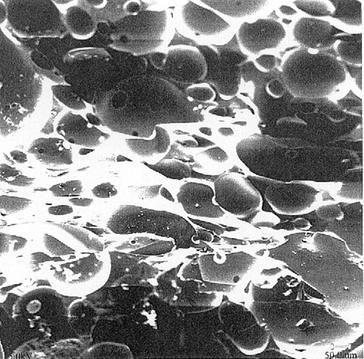
-
- SEM photomicrograph (100 X) of small lighter-green
glassy shard showing
multiple tiny air bubbles in sample. SEM Image: N. Reiter
-
-
-
- The new sample was also examined under long- and short-wave
UV lamps, but no fluorescence was noted. This suggests that the original
"luminous" quality reported by the rock's finder was short-lived
and non-reversible. This sample was also examined by Geiger counter, with
no rise in count-rate over ambient noted.
-
- An anecdote from this researcher's past, though, may
be germane. In years past I had worked at a major glass company in Toledo,
Ohio, as a technician involved with vacuum depositing of coatings on large-area
glass sheets. One of the materials we coated onto glass was a thin film
of fused silica (SiO2) as a wear-resistant coating. The process was performed
in a huge vacuum chamber, where silica sand was evaporated by electron
beam sources. Regularly we would have to shut the system down after a production
run and go inside the cavern-like chamber to clean off the cooling shields
and chamber walls. One anomaly that we observed, which was never adequately
explained, involved a faint greenish glowing of the flakes of "over-spray"
glassy fused silica on the cool chamber walls. On one occasion we observed
this faint glowing up to 24 hours after shutting the evaporation sources
down.
-
- Thus, although the reported anomalous glowing of our
fused glassy rock sample over a period of months is extra-ordinary, I have
personally observed the glowing of vaporized and condensed fused silica
for periods of multiple hours. Perhaps some analog is present.
-
-
-
-
- Soil Samples: Two soil samples,
requested by BLT Inc. in the spring of 2003, were obtained in May 2003;
these were received in the lab on 30 June 2003. One sample was taken from
the grass area where the rocks had been found and a control was obtained
about 25m away from the middle of the plowed field. Both soil samples were
dug down to about 4 inches into the soil.
-
- EDS analysis of granular soil tends to be somewhat problematic,
due to the physical heterogeneity of such samples (except in the case of
fine clays). "Dirt" is a complex material, and usually requires
several EDS scans from each sample to get an idea about overall composition.
-
- Examination of the soil sample taken from the grassy
area where the rocks were found shows a sandy or coarse-grained silty soil.
EDS shows normal soil ingredients, primarily Si, O and Al; Ca, K, Fe and
Mg are seen as minor peaks. EDS of control soil taken 25m away is ratiometrically
similar to the rock-area soils, with very similar signals of Si, Al (which
is slightly elevated over the rock-area soil), O, Ca, K, Fe and Mg, but
with traces of Mo (molybdenum) and P (phosphorus) which were not seen in
the rock-area soil.
-
-
-
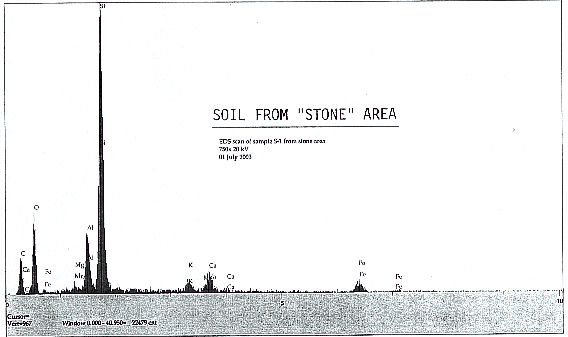
-
- EDS Scan of soil from stone area showing typical
soil ingredients,
primarily Si, O and Al; Ca, K, Fe and Mg are seen as minor peaks (750x
20kV).
Scan: N. Reiter, 1 July 2003
-
-
- We also observe another very interesting fact: the composition
of the soil taken from the area of the glassy stones contains most of the
same constituents as the glassy stones themselves--however, not all --
and not in any similar ratio. The glassy stones are much richer in Mg (magnesium),
with a minor Ti (titanium) peak visible (likely indicating rutile, a mineral
form of titanium dioxide). The soils said to be from the glassy stone area
have very little Mg, and no visible Ti (see following scans).
-
-
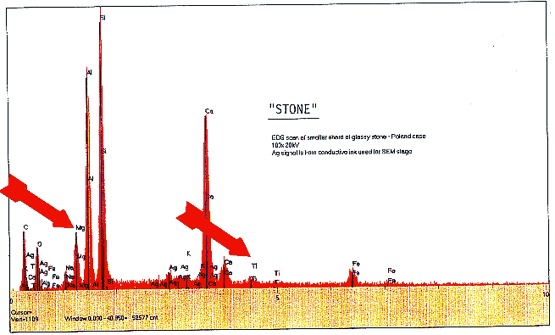
-
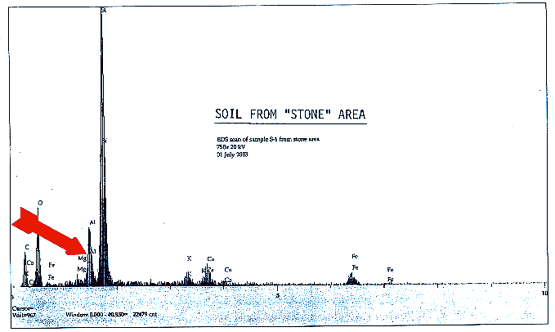
-
-
- EDS Scans of Stone (100 x 20kV) and Soils (750x
20kV) from
same area showing stronger Mg peak, and presence of Ti in stone only .
Scans: N. Reiter, 1 July 2003
-
-
-
-
- Laboratory Analysis (Infrared Spectroscopy): On July 8, 2003 a fragment of the "stone" retrieved
from a farm field in Poland in 1998 was submitted to Phyllis Budinger,
Frontier Analysis Ltd. Laboratory, for additional infrared spectroscopy
analysis.
-
- Procedure: The dark "stone"
fragment is approximately 9 x 7 x 2mm and weighs 0.2358 grams. An infrared
spectrum was taken of a tiny amount of ground material removed from the
fragment, using the Harrick SplitPea accessory on the Nicolet Avatar 360
spectrometer. Stereomicroscope photographs were obtained using the Leika
GZ6 microscope interfaced to a Kodak Digital Science MDS 120 camera.
-
- Results: Microscopic analysis
shows the material has a glassy appearance with some apparent bubbles.
This would suggest the material has been exposed to a temperature high
enough to cause "melting" of the mineral silicate in the sample
(see infrared analysis, below, on the identification of glass-like Si-O
bonds, and Nick Reiter's report, above).
-
-

-
- Two microphotographs of dark "stone"
fragment, showing glassy appearance
and apparent bubbles
Photos: Frontier Analysis Ltd Laboratory
-
-
-
- The infrared spectrum of the "stone" fragment
shows very broad absorption bands which are typical of an amorphous glass-like
substance. The frequencies of the bands (between 1050-900 cm _ and between
550-400 cm _) are definitely due to Si-O absorption. The spectrum is a
close comparison to a spectrum of lava, which is rock that has experienced
melting.1 These data suggest that the rock fragment originally contained
a high concentration of silica mineral (i.e., sand - a.k.a. quartz) that
has been subjected to high temperature. Glass (manufactured from 75% silica
plus other materials) requires temperatures of at least 700-800ºC
(1300-1500 F) in order to become glass.2
-
-
-
-
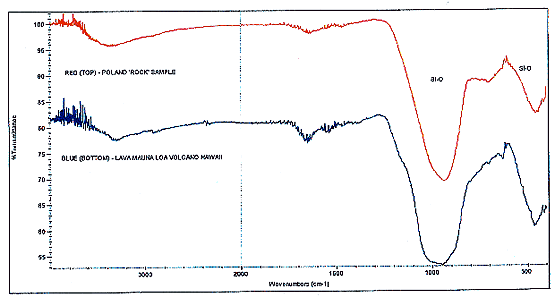
-
- Infrared spectrum of the "stone" sample
(red) along with a reference spectrum of lava (blue) for comparison. Infrared
Spectrum: Frontier Analysis Ltd. Laboratory
-
-
- ___________
-
- 1Lava specimen is from Mauna Loa on the island of Hawaii.
2Lewis, Richard K. Sr., Hawley's Condensed Chemical Dictionary, Fourteenth
Edition: John Wiley and Sons, Inc., 2002.
-
-
-
- -CONCLUSIONS-
-
- SEM/EDS ANALYSIS:
-
- (1) By all indications, the glassy stone samples provided
are most likely highly-vitrified soil. The source of this vitrification/conversion
to a glass remains unknown.
(2) The lighter-green areas of the stone (said to have fluoresced at the
time of retrieval and for several months following) are comprised of essentially
the same elements as the darker areas, but contain multiple tiny air bubbles
and voids which account for the lighter color in these areas;
(3) The composition of the soils from the area where the glassy stones
were found and the control soils 25m away is very similar, representing
typical soil components.
(4) The EDS scans of the glassy stones and the soils from the area where
the stones were found do not resemble each other ratiometrically -- indicating
that the vitrified stones are probably not derived from soils indigenous
to that precise location.
- --Nick Reiter, The Avalon Foundation
-
-
- INFRARED & MICROSCOPIC ANALYSIS:
-
- Infrared and microscopic examination of the stone shows
an amorphous and glassy Si-O containing material. Clearly the data supports
Nick Reiter's conclusions that this sample is soil that has been vitrified.
- --Phyllis Budinger, Frontier Analysis Ltd
-
-
-
- BLT Research Team Inc.
PO Box 400127
Cambridge, MA 02140 (USA)
ph: 617/492-0415
em: bltresearch@comcast.net
Date: January 30, 2004
|